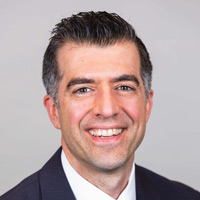2024 Investment Outlook: Three Tips for the New Year
What should investors do to protect their nest eggs as we head into a presidential election and face continued uncertainty about interest rates?


2023 was an interesting year for the investment markets as U.S. stocks and bonds finished up for the year. This was in spite of a continuing war in Ukraine, Hamas attacking Israel, a regional U.S. banking crisis and, oh by the way, the Federal Reserve raised interest rates to a 22-year high. Either way, I’ll take it. The question now is, what’s next for investors? Better yet, how should investors allocate their nest egg in 2024?
As we look to the year ahead, here are three examples of how I am advising my clients:
1. Cash is not always king.
There is a record amount of cash on the sidelines, $6 trillion in money market assets, according to Reuters. If you’re in a money market waiting for the right time to invest in the stock market, good luck. In my experience, it never feels like the right time to invest. There is always something — “the market is too expensive,” “the market is not cheap enough,” “the market is going to sell off,” or “I’ll wait a little longer,” so on and so forth. Sitting in cash may feel good in the short term, but after inflation and taxes, what is the real yield on your money?
From just $107.88 $24.99 for Kiplinger Personal Finance
Become a smarter, better informed investor. Subscribe from just $107.88 $24.99, plus get up to 4 Special Issues

Sign up for Kiplinger’s Free Newsletters
Profit and prosper with the best of expert advice on investing, taxes, retirement, personal finance and more - straight to your e-mail.
Profit and prosper with the best of expert advice - straight to your e-mail.
Instead, if you have money earmarked for the long term, 2024 could be a good year for dollar cost averaging a portion of your savings into a diversified portfolio. Dollar cost averaging is investing a steady amount each month into a mutual fund or a diversified portfolio of stocks, bonds, real estate and commodities, for instance. The idea is to spread out the entry points, buying into different prices of the market rather than making one single investment.
I especially like dollar cost averaging in 2024 given the amount of uncertainty in the economy and the uncertainty around interest rates. Dollar cost averaging does not ensure a profit or protect against loss, but rather than put all my capital to work at once, I’d rather spread it around evenly and see how the year develops.
2. Think twice before you give up on the unloved.
I will sometimes see investors wanting to sell underperforming stocks and buy only what’s performing well — like loading up on a few high-charging tech stocks and bailing on everything else. But be careful with this approach. This is because the unloved sectors of the stock market might start to attract investors’ attention again.
For example, take utility stocks, which had a tough year last year — the S&P Utilities Sector Index finished down 10.9% for 2023 (Bloomberg). However, that could change in 2024 if we see a weakening of the economy. Utility stocks can be seen as a defensive sector, meaning households will continue to need energy and water in economic downturns.
The point is to be careful about extrapolating too much from last year’s returns, or, as we say in the business: The past is no guarantee of future results. (For more on this, see Callan’s Periodic Table of Investments, a great piece on how no investment style wins consistently over time.)
3. Be mindful of the mega-trends.
Mega-trends are big, overarching themes that can be drivers of growth in many different industries for the next decade. For example, artificial intelligence and sustainability might be the next mega-trends.
Mega-trends can yield tremendous value (or not) for investors. There may be a few high-flying stocks that get all the attention from these themes, but time will tell whether the returns are real or fleeting. My advice here is twofold:
- Own the forest and not the tree. If it makes sense for your investment portfolio, owning a basket of securities benefiting from these mega-trends may be a better option than trying to find the needle in the haystack.
- Don’t bet the farm. Have a core well-diversified portfolio and consider adding satellites or small allocations if warranted.
It will be interesting to see how things unfold this year, especially around the Federal Reserve and our presidential election. One can make a case for being bullish as well as bearish. But I think most investors will be best served to avoid the short-term noise and focus more on building a portfolio for long-term gains.
Though these three tips are a good start, I recommend a thorough and comprehensive portfolio review by an experienced professional who can help evaluate your risk tolerance, time horizon, tax situation, goals and spending patterns.
To schedule your complimentary 2024 investment portfolio review with the author, make an appointment with him here.
Michael Aloi, CFP is an independent financial advisor with 22 years of experience in helping clients achieve their financial goals. He works with clients throughout the United States. For more information, please visit www.michaelaloi.com.
Investment advisory and financial planning services are offered through Summit Financial LLC, an SEC Registered Investment Adviser, 4 Campus Drive, Parsippany, NJ 07054. Tel. 973-285-3600 Fax. 973-285-3666.
This material is for your information and guidance and is not intended as legal or tax advice. Clients should make all decisions regarding the tax and legal implications of their investments and plans after consulting with their independent tax or legal advisers. Individual investor portfolios must be constructed based on the individual’s financial resources, investment goals, risk tolerance, investment time horizon, tax situation and other relevant factors. Past performance is not a guarantee of future results.
The views and opinions expressed in this article are solely those of the author and should not be attributed to Summit Financial LLC. Links to third-party websites are provided for your convenience and informational purposes only. Summit is not responsible for the information contained on third-party websites. The Summit financial planning design team admitted attorneys and/or CPAs, who act exclusively in a non-representative capacity with respect to Summit’s clients. Neither they nor Summit provide tax or legal advice to clients. Any tax statements contained herein were not intended or written to be used, and cannot be used, for the purpose of avoiding U.S. federal, state or local taxes.
Related Content
- How to Get the Most Out of Your Pension Plan
- Four Tips to Help You Conquer the Retirement Mountain
- Three Potentially Costly IRA Mistakes That Are Easy to Avoid
- Three Investments That Put Your Money to Work With Less Risk
- (A Little) Greed Is Good When It Comes to Investing
Profit and prosper with the best of Kiplinger's advice on investing, taxes, retirement, personal finance and much more. Delivered daily. Enter your email in the box and click Sign Me Up.

Michael Aloi is a CERTIFIED FINANCIAL PLANNER™ Practitioner and Accredited Wealth Management Advisor℠ with Summit Financial, LLC. With 21 years of experience, Michael specializes in working with executives, professionals and retirees. Since he joined Summit Financial, LLC, Michael has built a process that emphasizes the integration of various facets of financial planning. Supported by a team of in-house estate and income tax specialists, Michael offers his clients coordinated solutions to scattered problems.
-
 Dow Adds 646 Points, Hits New Highs: Stock Market Today
Dow Adds 646 Points, Hits New Highs: Stock Market TodayIt was "boom" for the Dow but "bust" for the Nasdaq following a December Fed meeting that was less hawkish than expected.
-
 5 Types of Gifts the IRS Won’t Tax: Even If They’re Big
5 Types of Gifts the IRS Won’t Tax: Even If They’re BigGift Tax Several categories of gifts don’t count toward annual gift tax limits. Here's what you need to know.
-
 The 'Scrooge' Strategy: How to Turn Your Old Junk Into a Tax Deduction
The 'Scrooge' Strategy: How to Turn Your Old Junk Into a Tax DeductionTax Deductions We break down the IRS rules for non-cash charitable contributions. Plus, here's a handy checklist before you donate to charity this year.
-
 I'm a Tax Attorney: These Are the Year-End Tax Moves You Can't Afford to Miss
I'm a Tax Attorney: These Are the Year-End Tax Moves You Can't Afford to MissDon't miss out on this prime time to maximize contributions to your retirement accounts, do Roth conversions and capture investment gains.
-
 I'm an Investment Adviser: This Is the Tax Diversification Strategy You Need for Your Retirement Income
I'm an Investment Adviser: This Is the Tax Diversification Strategy You Need for Your Retirement IncomeSpreading savings across three "tax buckets" — pretax, Roth and taxable — can help give retirees the flexibility to control when and how much taxes they pay.
-
 Could an Annuity Be Your Retirement Safety Net? 4 Key Considerations
Could an Annuity Be Your Retirement Safety Net? 4 Key ConsiderationsMore people are considering annuities to achieve tax-deferred growth and guaranteed income, but deciding if they are right for you depends on these key factors.
-
 I'm a Financial Pro: Older Taxpayers Really Won't Want to Miss Out on This Hefty (Temporary) Tax Break
I'm a Financial Pro: Older Taxpayers Really Won't Want to Miss Out on This Hefty (Temporary) Tax BreakIf you're age 65 or older, you can claim a "bonus" tax deduction of up to $6,000 through 2028 that can be stacked on top of other deductions.
-
 Meet the World's Unluckiest — Not to Mention Entitled — Porch Pirate
Meet the World's Unluckiest — Not to Mention Entitled — Porch PirateThis teen swiped a booby-trapped package that showered him with glitter, and then he hurt his wrist while fleeing. This is why no lawyer will represent him.
-
 Smart Business: How Community Engagement Can Help Fuel Growth
Smart Business: How Community Engagement Can Help Fuel GrowthAs a financial professional, you can strengthen your brand while making a difference in your community. See how these pros turned community spirit into growth.
-
 In 2026, the Human Touch Will Be the Differentiator for Financial Advisers
In 2026, the Human Touch Will Be the Differentiator for Financial AdvisersAdvisers who leverage innovative technology to streamline tasks and combat a talent shortage can then prioritize the irreplaceable human touch and empathy.
-
 How Financial Advisers Can Deliver a True Family Office Experience
How Financial Advisers Can Deliver a True Family Office ExperienceThe family office model is no longer just for the ultra-wealthy. Advisory firms will need to ensure they have the talent and the tech to serve their clients.